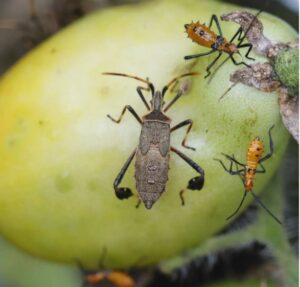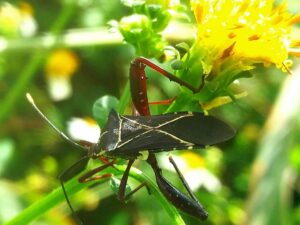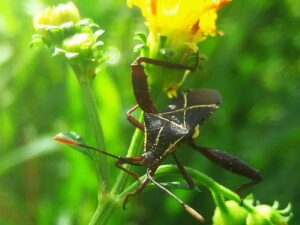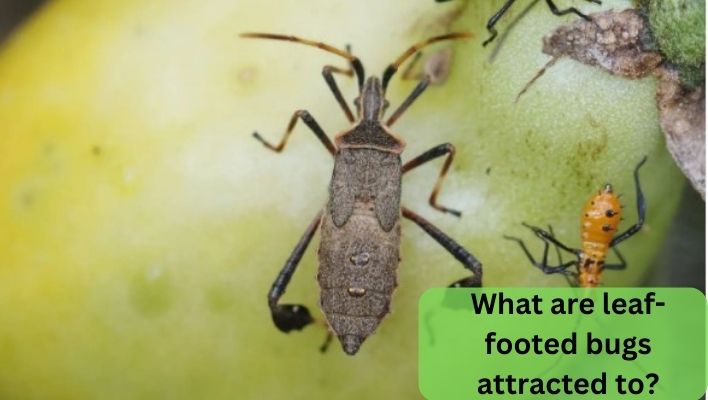Are you tired of finding leaf footed bugs everywhere on your property? These pests can be a nuisance and can cause damage to your plants and trees. But what are they attracted to in the first place?
Understanding what attracts leaf footed bugs can help you take proactive measures to prevent them from infesting your property. By understanding what draws these pesky bugs to your garden, you can take proactive steps to prevent them from wreaking havoc on your plants and crops.
In this article, we’ll dive into what leaf footed bugs are attracted to and how you can prevent them from being drawn to your plants, fruits, and nuts. From food sources to shelter and mating opportunities, we’ll cover everything you need to know to keep these pesky bugs at bay.
What are leaf footed bugs attracted to?
Leaf footed bugs are attracted to various factors, including food sources, shelter, mating opportunities, light sources, and heat sources. Let’s explore each of these factors in more detail:
Food Sources:
Leaf footed bugs are attracted to plants, fruits, and nuts. They are particularly fond of citrus, tomatoes, and pecans. These pests use their piercing mouthparts to suck the sap from the plants, causing damage to the fruit and nuts.
They are also known to feed on nuts such as pecans and almonds. If you notice leaves with small brown spots, misshapen fruits, or premature fruit drop, these could be signs of leaf footed bug damage.
Shelter:
Leaf footed bugs are also attracted to trees, bushes, and buildings that provide shelter. They prefer to rest on the underside of leaves, making them difficult to spot. They also congregate in large numbers on trees during the cooler months.
If you have tall weeds or overgrown shrubs, they can provide a hiding spot for these pests. They may also seek shelter in buildings, such as barns and sheds.

Mating Opportunities:
Leaf footed bugs are attracted to pheromones released by other bugs of the same species. This means that if there are already leaf footed bugs on your property, others will likely be attracted to it.
They may also be drawn to other insects that are potential prey, which can increase their population.
Light Sources:
Leaf footed bugs are attracted to light sources, both artificial and natural. They are often found around outdoor lights at night, and during the day, they may congregate in areas with direct sunlight. If you have outdoor lights, consider turning them off at night to avoid attracting leaf footed bugs.
Heat Sources:
Leaf footed bugs are attracted to warm temperatures and compost piles. They may also be attracted to the heat generated by buildings or other structures. If you have a compost pile, keep it covered to avoid attracting these pests.
By understanding what leaf footed bugs are attracted to, you can take steps to prevent them from infesting your property. Regularly inspect your plants for signs of damage, keep your property free of debris, and consider using traps or natural pest control methods to keep leaf footed bugs at bay.
To identify leaf footed bugs, look for their distinct shape and markings, which include a flattened, elongated body with leaf-like projections on their hind legs. They also have a distinct scent, which can help you identify their presence.
- 【The PUREST Neem Oil on the Market!】- Plantonix Neem Bliss is freshly made from the fruit kernels of the neem plant, without the use of any heat or additives! The cold press process retains essential nutrients, ensuring you always get the best results for your garden, soil, or irrigation system!
- 【Easy to Use for Many Applications!】- To use for plants, simply mix 1.5 teaspoons of Plantonix Neem Bliss per 1 quart of water. Then, add half a teaspoon of dish soap per 1 quart of water. Spray the diluted Neem Bliss on all leaf surfaces, and then reuse every 2-4 weeks for best results!
- 【Highly Concentrated and Soluble!】- All Neem Bliss is heavily concentrated and made with zero additives, making it easy to reuse on farms, lawns, and indoor and outdoor gardens! The main active ingredient in Neem Bliss is azadirachtin, allowing it to be highly soluble and ideal for topical applications.
How to get rid of leaf footed bugs
Leaf footed bugs can be a stubborn pest to get rid of, but several methods can be effective in controlling their populations. Here are some strategies you can try:
- Hand-pick the bugs: One of the most effective ways to control leaf-footed bugs is to hand-pick them off your plants and drop them into a bucket of soapy water. This process is time-consuming, but it can be very effective for small infestations.
- Use insecticidal soap: Insecticidal soap can be an effective method for controlling leaf footed bugs. Look for a soap specifically formulated for plant use, and follow the instructions carefully.
- Try neem oil: Neem oil is a natural pesticide that can be effective against leaf-footed bugs. Mix a small amount of neem oil with water and spray it directly onto your plants. Be sure to follow the instructions on the label carefully.
- Cover crops: Use cover crops such as marigolds, clover, or buckwheat to help control leaf-footed bugs. These plants are not attractive to the bugs and can help reduce their numbers.
- Use row covers: Covering your plants with row covers can help to prevent leaf-footed bugs from laying eggs on your plants. This method can be particularly effective for crops such as tomatoes and peppers.
- Pyrethrin: Pyrethrin is a chemical insecticide that can effectively control leaf-footed bugs. It works by attacking the bugs’ nervous system, causing paralysis and death. However, it can also harm beneficial insects and should be used with caution.
- Attract natural predators: Encouraging natural predators such as birds, spiders, and other insects can effectively control leaf-footed bugs. Provide nesting boxes for birds and plant flowers that attract beneficial insects.

It’s important to note that prevention is key when it comes to controlling leaf footed bugs. By maintaining a clean and healthy garden, using natural repellents and traps, and covering your fruits and nuts with protective netting, you can prevent infestations from taking hold in the first place.
Using a combination of these methods, you can effectively control leaf-footed bugs and protect your plants from damage. Remember to monitor your plants regularly and take action as soon as you notice any signs of infestation. However, these methods can help you eliminate these bugs if you do have an infestation.
How to Prevent leaf-footed bug Infestations
Preventing leaf footed bug infestations is key to protecting your plants and crops from damage. Here are some tips and strategies you can use to avoid these pesky bugs from taking over:
Maintain your garden:
Keeping your garden clean and tidy is the first line of defense against leaf-footed bugs. Remove weeds, debris, and dead plants from your garden regularly, and keep the area around your plants free of fallen leaves and other plant matter.
Use natural repellents:
Natural repellents like neem oil and insecticidal soap can effectively deter leaf-footed bugs. You can also try planting companion plants like marigolds to help repel these pests.
Natural repellents such as garlic spray or hot pepper wax can help to deter leaf footed bugs from your plants. Apply these repellents regularly for best results.
Cover your crops:
Covering your crops with fine mesh netting can help prevent leaf-footed bugs from accessing them. This is especially important for fruit and nut trees. Make sure the netting is tight-fitting and secure to keep the bugs out.
Install sticky traps:
Yellow sticky traps can be effective in trapping adult leaf-footed bugs. Place them strategically around your garden to catch these pests before they have a chance to lay eggs.
Early detection and control measures:
Regularly inspect your plants for signs of leaf-footed bug infestations, such as yellowing leaves or stunted growth. If you spot any of these signs, immediately control the infestation before it gets out of hand. You can use physical control methods like handpicking the bugs or using a vacuum cleaner to remove them.

Early detection and control measures are crucial in preventing leaf-footed bug infestations. By taking proactive steps to keep your garden clean and using natural repellents, you can help protect your plants and crops from these pesky pests.
By taking these steps, you can help prevent leaf footed bug infestations and protect your plants and crops from damage. Remember, early detection and control measures are key to preventing infestations from taking hold.
FAQs
What are the benefits of leaf footed bugs?
Leaf footed bugs are not considered beneficial insects as they can cause significant damage to crops and plants. However, they have some beneficial effects on your garden or crops.
They are known to feed on other pests, such as aphids or caterpillars, which can help to keep those populations in check. Also, they play a role in the ecosystem as a food source for predators such as birds, spiders, and other insects.
How do leaf footed bugs reproduce?
Leaf-footed bugs reproduce sexually, with females laying eggs on the underside of leaves. The eggs hatch into nymphs, which go through several molts before adulthood.
How can I identify leaf-footed bugs?
Leaf footed bugs are easily identifiable by their distinctive flattened hind legs resembling leaves. They are typically brown or gray and can range in size from about ½ inch to 1 inch in length.
They also have a distinctive “V” shape on their backs. You can often find them on plants, where they feed on sap or fruit.
What plants are most attractive to leaf footed bugs?
Leaf footed bugs are attracted to various plants, but some of their favorites include tomatoes, peppers, eggplants, okra, and various types of fruit trees such as peaches, citrus, and pomegranates.
What time of year are leaf footed bugs most active?
Leaf footed bugs are most active during the warmer months, typically from late spring through early fall. They can be more active during drought, or when food sources are limited, so it’s important to keep an eye on your plants during these times.
Conclusion
Leaf footed bugs can be a major pest for gardeners and farmers, causing damage to crops and plants. Understanding what attracts these bugs and how to prevent and control infestations can protect your plants and minimize the damage.
Leaf-footed bugs are attracted to certain plants and environmental conditions, including warm temperatures and plants such as tomatoes, peppers, and fruit trees. To prevent infestations, it’s important to maintain a clean and well-maintained garden, use natural repellents and traps, and cover fruits and nuts with protective netting.
Early detection and control measures are also crucial for preventing infestations from taking hold. Check your plants regularly for signs of leaf footed bugs and use control measures such as hand-picking the bugs or using insecticidal soap or neem oil to control their numbers.
We encourage you to take action to prevent and control leaf footed bug infestations in your garden or farm. These tips and strategies can protect your plants and help you enjoy a healthy and thriving garden.

